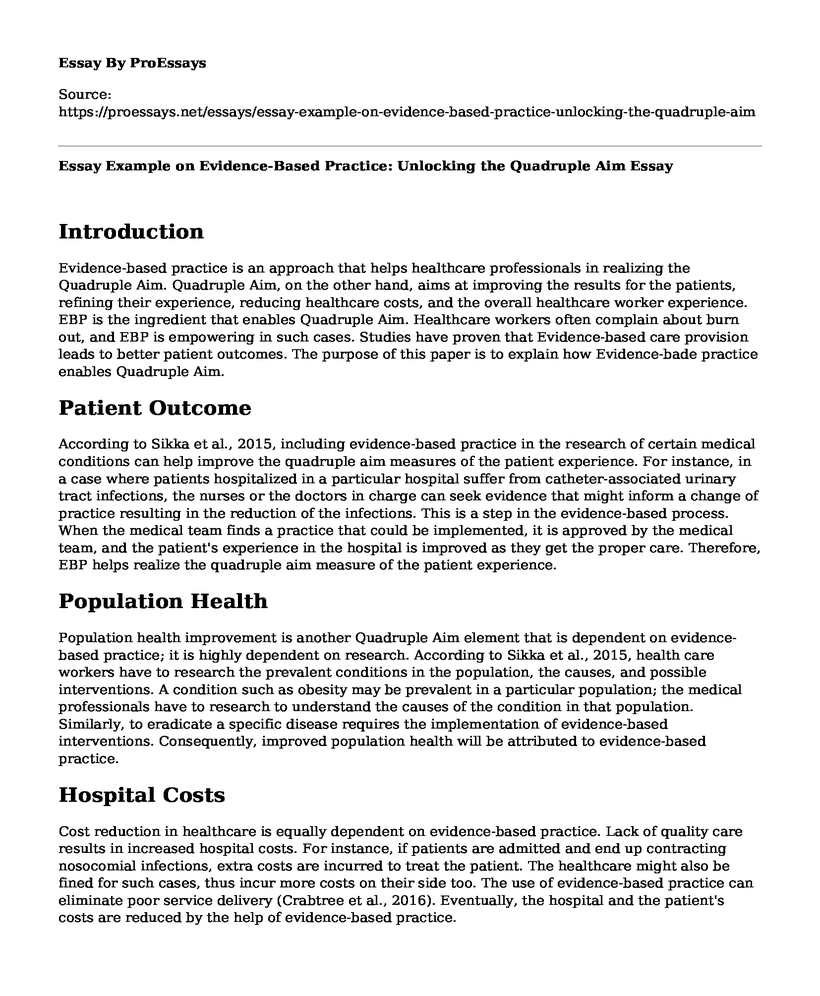Introduction
Evidence-based practice is an approach that helps healthcare professionals in realizing the Quadruple Aim. Quadruple Aim, on the other hand, aims at improving the results for the patients, refining their experience, reducing healthcare costs, and the overall healthcare worker experience. EBP is the ingredient that enables Quadruple Aim. Healthcare workers often complain about burn out, and EBP is empowering in such cases. Studies have proven that Evidence-based care provision leads to better patient outcomes. The purpose of this paper is to explain how Evidence-bade practice enables Quadruple Aim.
Patient Outcome
According to Sikka et al., 2015, including evidence-based practice in the research of certain medical conditions can help improve the quadruple aim measures of the patient experience. For instance, in a case where patients hospitalized in a particular hospital suffer from catheter-associated urinary tract infections, the nurses or the doctors in charge can seek evidence that might inform a change of practice resulting in the reduction of the infections. This is a step in the evidence-based process. When the medical team finds a practice that could be implemented, it is approved by the medical team, and the patient's experience in the hospital is improved as they get the proper care. Therefore, EBP helps realize the quadruple aim measure of the patient experience.
Population Health
Population health improvement is another Quadruple Aim element that is dependent on evidence-based practice; it is highly dependent on research. According to Sikka et al., 2015, health care workers have to research the prevalent conditions in the population, the causes, and possible interventions. A condition such as obesity may be prevalent in a particular population; the medical professionals have to research to understand the causes of the condition in that population. Similarly, to eradicate a specific disease requires the implementation of evidence-based interventions. Consequently, improved population health will be attributed to evidence-based practice.
Hospital Costs
Cost reduction in healthcare is equally dependent on evidence-based practice. Lack of quality care results in increased hospital costs. For instance, if patients are admitted and end up contracting nosocomial infections, extra costs are incurred to treat the patient. The healthcare might also be fined for such cases, thus incur more costs on their side too. The use of evidence-based practice can eliminate poor service delivery (Crabtree et al., 2016). Eventually, the hospital and the patient's costs are reduced by the help of evidence-based practice.
Healthcare Professional Satisfaction
Quadruple Aim, the healthcare provision segment, is also working to consider the well-being of the health care workers; it aims at ensuring that the workers find joy, satisfaction, and resilience in their work. Evidence-based practice is playing an essential role in ensuring that healthcare workers find satisfaction in care delivery. According to Beckett & Melnyk, 2018, including evidence-based practice in decision making and interventions, nurses can decide what treatment a patient should get without any struggle. Without the use of the evidence-based practice in nursing care, professionals will face many difficulties (Beckett & Melnyk, 2018). Research has also contributed to the improvement in technology in the healthcare sector, which has significantly improved the professionals' well-being. Research also dictates nurses working hours that are appropriate to prevent burnout, thus quality care provision for the patients and nurse well-being. The introduction of evidence-based practice has improved the nurse working hours and reduced the paperwork for the care teams ensuring that they do not experience burnout. The implementation of evidence-based practice, therefore, has brought the caregivers satisfaction and joy in their work.
Conclusion
The achievement of Quadruple Aim is hugely reliant on evidence-based practice. Quality service delivery, according to EBP guidelines, has a significant impact on patient outcomes. Evidence-based practice has also shown to improve population health. Delivery of services as per EBP reduces hospital costs as well. Evidence-based knowledge is also significant in the improvement of the healthcare professional's well-being. Evidence-based practice is, therefore, the secret sauce that empowers Quadruple Aim.
References
Beckett, C. D., & Melnyk, B. M. (2018). EvidenceBased Practice Competencies and the New EBP C Credential: Keys to Achieving the Quadruple Aim in Health Care. Worldviews on Evidence-Based Nursing, 15(6), 412-413. https://doi.org/10.1111/wvn.12335
Crabtree, E., Brennan, E., Davis, A., & Coyle, A. (2016). Improving Patient Care Through Nursing Engagement in Evidence-Based Practice. Worldviews on Evidence-Based Nursing, 13(2), 172-175. https://doi.org/10.1111/wvn.12126
Sikka, R., Morath, J. M., & Leape, L. (2015). The Quadruple Aim: care, health, cost, and meaning in work. BMJ Quality & Safety, 24(10), 608-610. https://doi.org/10.1136/bmjqs-2015-004160
Cite this page
Essay Example on Evidence-Based Practice: Unlocking the Quadruple Aim. (2023, Apr 09). Retrieved from https://proessays.net/essays/essay-example-on-evidence-based-practice-unlocking-the-quadruple-aim
If you are the original author of this essay and no longer wish to have it published on the ProEssays website, please click below to request its removal:
- Substance Abuse in Opioids Research Paper
- Health Problems in Urban Community Essay
- Paper Example on Soft Tissue Injury and Dysfunction
- Essay on Health Administrators: Challenges & Solutions in a Brain Death Scenario
- Essay Sample on Nursing: Critical Thinking & Innovative Learning Methods for Quality Care
- Essay Example on Pharmacists: Criminal Law & Medicine Intersection Risk Analysis
- Paper Example: International Disaster Risk Factors







